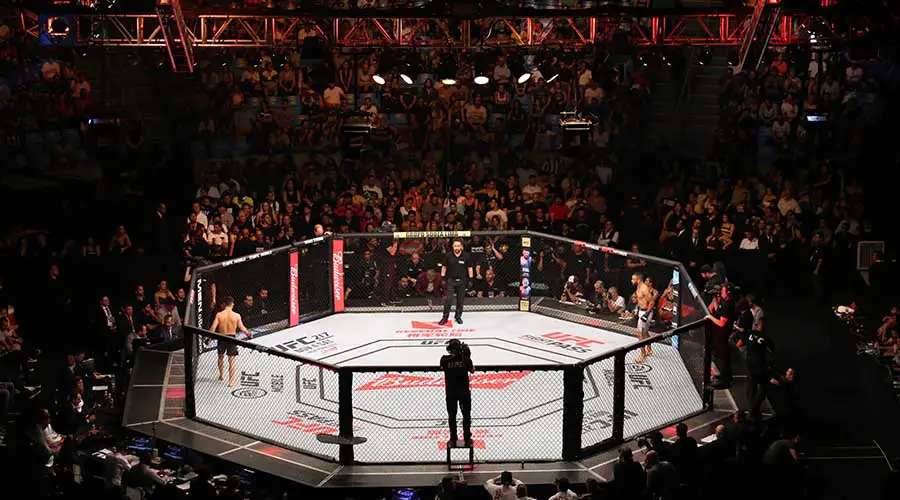MMA, also known as Mixed Martial Arts, is a form of competition that encompasses techniques from various fights, such as boxing, judo and jiu-jitsu.
Despite its vale-tudo character, a set of unified rules have been created by the sport’s main organisations to regulate combat, guaranteeing integrity, fairness and, above all, safety for practitioners.
In this complete and up-to-date guide, you will understand the MMA rules, such as permitted blows, illegal moves, round lengths and penalties.
By understanding these guidelines, you’ll be able to appreciate the strategic complexity and technical rigour behind this sport that challenges physical limits.
Check it out 👇
First MMA rules
Although there are reports of similar fights in Ancient Greece, MMA as it is known today was created by the Brazilian Gracie family in the 1920s.
Back then, patriarchs Carlos and Hélio organised fights between practitioners of various martial arts. The aim was to show that the jiu-jitsu developed by the family was capable of beating other disciplines.
In the beginning, the fights had no time limit and were held in the “vale-tudo” format, i.e. without many restrictions on blows and techniques.
The fights became so famous that they began to gain fans in several countries, especially the United States. It was there that the Ultimate Fighting Championship (UFC) was created in November 1993.
Rorion Gracie, Art Davie, Bob Meyrowitz, Campbell McLaren and John Milius are considered to be the founders of the event, which became the most important in the segment and helped MMA to become popular in the rest of the world.
Over the years, MMA has evolved into a highly regulated form of competition, incorporating elements of various martial arts and gaining international acceptance as a legitimate sport.
Nowadays, the competitive scene includes tournaments other than the UFC, such as Bellator, the Professional Fighters League and One Championship.
As a result, the sport’s regulatory bodies have reached a consensus on the main rules of MMA, which have begun to be incorporated into various tournaments. Some elements may vary from event to event, but the vast majority of the rules are followed to the letter.
Duration of an MMA fight

Normal MMA bouts, such as those in the UFC, usually consist of three rounds of five minutes each. However, depending on the importance of the event, the number of rounds can increase to five. This is what happens, for example, in the famous belt fights.
At the end of each round, the participants are entitled to a minute’s rest to catch their breath, talk to the coach, carry out medical procedures and, above all, review combat strategies. If a fighter is more seriously injured, the referee is free to stipulate a longer break.
How do you win an MMA fight?
In MMA, a victory can be declared in various ways. The most common are: when a fighter hits the ground indicating that he can no longer continue or when a referee decides that the fighter is not fit to continue fighting, whether due to technical knockouts, fainting or similar situations.
A victory can also be declared: when the coach throws in the towel in the octagon, when the bleeding from an injury is not stopped, when a fighter violates the rules of the competition or when time runs out.
In the latter case, the referees decide who the winner will be, using evaluation criteria such as the effectiveness of the blows, control of the fight and aggressiveness.
What blows are allowed in MMA?

- Punches
- Kicks
- Knees
- Elbows
- Submissions
- Grabbing in the floor
Which blows are not allowed in MMA?
- Blows to the eyes
- Blows to the spine
- Blows to the back of the head
- Blows to the throat
- Blows to the groin
- Blows with outstretched fingers
- Knee to the head of a fallen opponent
- Kicking a fallen opponent in the head
- Stepping on a fallen opponent
- Elbows from above
- Pulling hair
- Biting the opponent
- Spitting on the opponent
- Headbutting
- Putting your finger in your opponent’s mouth or nose
- Holding the opponent’s glove
- Grabbing the opponent’s shorts
- Throwing the opponent out of the octagon
- Intentionally avoiding contact
MMA penalties
In MMA, there are basically three types of penalties: verbal warning, point deduction and elimination from the fight.
The verbal warning is the most basic of all. In it, the referee talks to the fighter and explains that if he continues to break a particular rule, he could be penalised with a more serious sanction.
If the warning isn’t enough, a point deduction is applied. If the fight ends in a draw, these points can make the difference in the judges’ decision, who will take into account the infractions committed throughout the rounds.
If an offence is very serious, such as disrespecting the referees or continuing to hit an opponent who has already been knocked out, the fighter can be eliminated.
MMA ring dimensions

MMA fights take place in an eight-sided ring called an octagon. In the UFC, the distance between the opposite corners (measured between the ends of two consecutive opposite sides) is approximately 9.75 metres.
In addition, each side of the octagon is divided by protective bars, and the distance between them is standardised. That said, the total area is 64 square metres and it is in this space that the fighters move around.
What is MMA equipment?
In MMA fights, it is compulsory to wear some equipment, such as gloves that leave your fingers free, mouthguards, genital protectors and some kind of clothing, usually shorts and tops (women).
There is also equipment that is considered optional, such as knee pads, elbow pads, bandages and Vaseline (only on the face).
What are the weight categories in MMA?
- Strawweight | Up to 52.2 kg
- Flyweight | Up to 56.7 kg
- Bantamweight | Up to 61.2 kg
- Featherweight | Up to 65.8 kg
- Lightweight | Up to 70.3 kg
- Super Lightweight | Up to 74.8 kg
- Welterweight | Up to 77.1 kg
- Super Welterweight | Up to 79.4 kg
- Middleweight | Up to 83.9 kg
- Super Middleweight | Up to 88.5 kg
- Light Heavyweight | Up to 93 kg
- Cruiserweight | Up to 102.1 kg
- Heavyweight | Up to 120.2 kg
- Super Heavyweight | No limit
Now you know the rules of MMA and are ready to watch the fights without getting lost! Did you like this content? Leave your opinion in the comments. And don’t forget to visit our website whenever you can, OK? 💪



